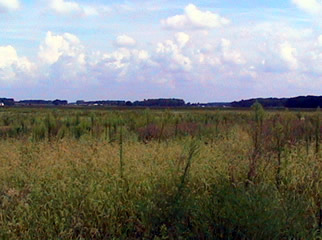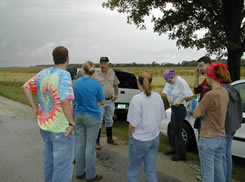 |
 |
 |
 |
 |
||
|
|||||||||
 Limberlost
Restoration Limberlost
Restoration The Limberlost Swamp, parts of which are now known as the Loblolly Marsh, spanned Jay and Adams Counties, in east central and northeast Indiana. The Limberlost was once a very large and dense swampland of 13,000 acres, with many species of plants and animals thriving within. When settlers came to Indiana in the 1800s, they were more interested in farmland than they were in an overgrown swamp. Over the next hundred years, the trees and swampland were cleared to make room for farmland. Unfortunately for the farmers, the land would continually try to revert back to its original state as a wetland. For years, farmers have had to deal with crops ruined by the amount of water that soaked their land. Some fields became so damaged that they could never produce a harvest again. Drainage tiles, which provided farmers a means of draining water off their cropland into huge ditches, had been moderately successful in making the land tillable, but in times of heavy rain the tiles clogged with silt, the ditches overflowed, and the farmland became flooded as deep as several feet. Although the water kept coming each year, most farmers continued to plant their crops with the hope that their fields might not flood.
Ken Brunswick, a former dairy farmer and now part of the Department of Natural Resources, started the restoration process after he re-read the nature studies of Gene Stratton-Porter. The famous nature writer and novelist wrote several books describing how the Limberlost used to be. Brunswick began to document the flooding of the fields with photographs in the early 1990s. His work eventually led to the creation of the restoration project, Limberlost Swamp Remembered, in late 1991. Ken and a few volunteers began encouraging public involvement to restore the swamp, starting with the twelve acres of Bird Sanctuary that was donated to the state in 1947. By 2002, more than 1,000 acres of farmland had been acquired for eventual restoration, with Loblolly Marsh as the biggest success story for the Limberlost. The Loblolly, in its few short years as a restored marsh, has already attracted many species of birds, mammals, and insects that once lived in the area, and latent seeds in the ground from prairie grasses and forbs, and other native plants, have likewise "awakened." The land is starting to thrive, but more land must be restored. When land is bought from farmers to restore, a few things need to be done before the restoration process begins. First, the land is classified to determine how to restore it. The more organic soils are turned into marshy emergent, areas near the Wabash become flood plains, and the woodland areas are restored as flatwood wetlands. To restore the Loblolly, forty - fifty feet of drainage tiles that empty into open ditches were plugged at both ends with concrete. Normally, the open ditches are filled, but the channels in the Loblolly are left open because some neighboring farmland is still being drained. Levees are constructed along the ditches to support the water collecting behind. If water still manages to seeps out through the soil, a twelve-inch wide and six-foot deep trench is dug, then filled with dry clay to create another barrier. Today, many individuals and organizations concerned with wetland restoration exist in addition to the Limberlost Swamp Remembered. Organizations such as the Ropchan Foundation and Indiana Heritage Trust, as well as many individual donations and volunteer efforts by a variety of visitors and surrounding community members, work together to buy non-tillable land from farmers and restore the territory to wetlands. Our seminar has contributed to the restoration process by working on a key 4.37-acre plot (it will be a new entry point for visitors into the Limberlost) and hundreds of acres surrounding it. Before we started to work on our plot of land, we made a trip to Limberlost Cabin to learn more about the Limberlost and the land we were planning to restore. With the help of Ken Brunswick and Nancy Carlson, who is a telecommunications professor at Ball State University and a Gene Stratton-Porter enthusiast, we were able to grasp how tragic the loss of the Limberlost was to Stratton-Porter and to her community of Geneva. With a new understanding of the importance of restoration, we made plans to return to Geneva and get our hands dirty.
We gained firsthand experience in restoration work on two separate occasions. (See photos.) The first time we went, the weather was completely against us. One team of students braved heavy rainfall to survey the 4.37 acres with professional surveying equipment. Calculations of the correct elevations and distances would allow Ken and others to create a map of the acreage and plan for its future use as a visitor entryway. Two other teams of students located and marked drainage tiles on the surrounding 200+ acres. Unfortunately, the tiles were not easy to find in the deep drainage ditches, which were overgrown with tall grasses. After a couple hours, however, the teams were able to find, mark, and photograph the tiles for federal surveyors.
On our second trip, we had much nicer working conditions. Our job on this occasion was to plant native trees and prairie plants. More than 60 New England asters, compass plants, and other prairie plants went into the ground on our 4.37 acres, along with a dozen white and burr oaks. Nearby, in order to create a corridor that will shelter animals passing between two wooded areas, we planted more than eighty red oak saplings. To end our day, we went to another part of the Limberlost and harvested prairie grass seeds—switchgrass and Indian grass—which would then be planted in different parts of the Limberlost the following spring. Our time at the Limberlost was a memorable and rewarding experience. We were able to help restore land and learn more about the environment around us. Restoring the Limberlost Swamp is a worthy cause. With time, care, and a few willing volunteers, part of the Limberlost may one day reflect its original grandeur. To learn more about restoring the Limberlost, or how you can help with the restoration process, please contact the Limberlost Swamp Remembered or the Limberlost State Historic Site. On our site, visit the environmental issues and special projects sections for more information. |
|
||||||||||||||||||||





